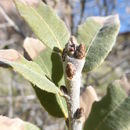More info for the terms:
association,
codominant,
forest,
habitat type,
series,
woodlandArizona white oak is found in diverse communities along elevation or
moisture gradients from savannas, semidesert grasslands, and interior
chaparral [
10,
57] to Madrean evergreen woodland and pine-oak (Pinus
spp.-Quercus spp.) communities [
7]. Arizona white oak is codominant
with Emory oak (Q. emoryi) and gray oak in the encinal mixed woodland
series and Madrean evergreen woodland series [
9,
19,
38,
52]. Arizona
white oak habitat series occur in savannas of New Mexico [
19]. Arizona
white oak is an indicator species in dry Douglas-fir (Pseudotsuga
menziesii), Chihuahua pine (Pinus leiophylla var. chihuahuana),
ponderosa pine (P. ponderosa), and Apache pine (P. engelmannii) habitat
and community types [
1,
3,
55,
63]. Arizona white oak is dominant or
codominant in open and closed-canopy pinyon-juniper (Juniperus spp.)
woodlands [
28,
53]. Occasionally, Arizona white oak is an important
understory species in pinyon-juniper stands [
58] and Mexican pinyon (P.
cembroides) forests [
46]. Isolated Arizona white oak occur infrequently
in riparian woodland associations, such as Arizona walnut (Juglans
major) and Arizona sycamore (Platanus wrightii) community types with
permanent or semipermanent streams [
43,
44,
69,
73,
75]. Arizona white oak
occurs on edges of interior chaparral of Arizona in communities such as
the Arizona white oak-yellowleaf silktassel (Garrya flavescens)-Emory
oak association [
11,
13,
35,
63]. Some of the publications in which
Arizona white oak is listed as a dominant or indicator species are:
(1) Forest and woodland habitat types (plant associations) of Arizona
south of the Mogollon Rim and southwestern New Mexico [
3]
(2) Forest habitat types south of the Mogollon Rim, Arizona and New
Mexico [
18]
(3) Classification of mixed broadleaf riparian forest in Tonto National
Forest [
37]
(4) A series vegetation classification for Region 3 [
52]
(5) A forest habitat type classification of southern Arizona and its
relationship to forests of the Sierra Madre Occidental of Mexico [
54]
(6) Vegetation of the Santa Catalina Mountains, Arizona: a gradient
analysis of the south slope [
82].
Woody species associated with Arizona white oak but not previously
mentioned in Distribution and Occurrence information include Arizona
madrone (Arbutus arizonica), Arizona rosewood (Vaquelina californica),
and coral-bean (Erythrina flabeliformis) [
45,
55].

